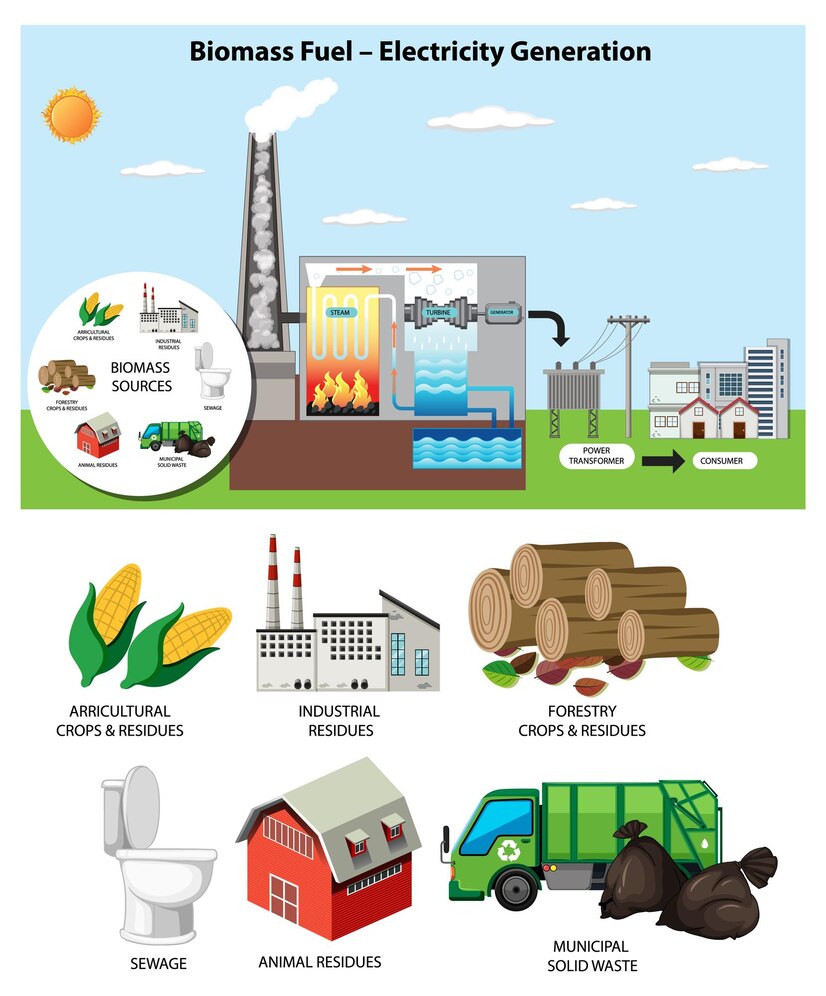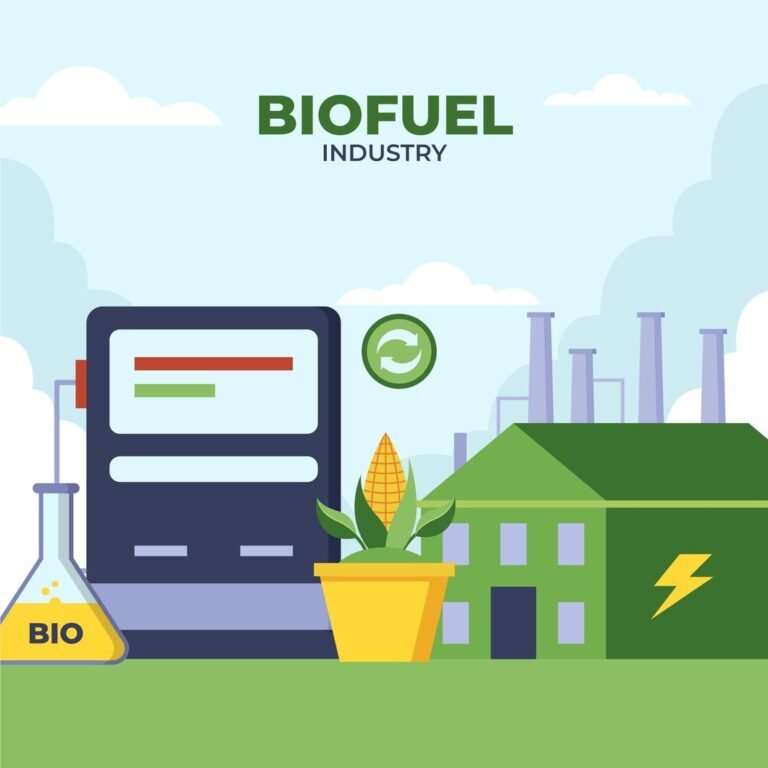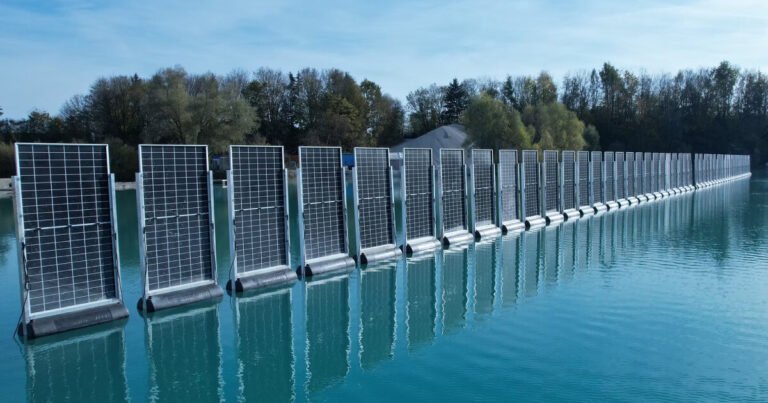Pros and Cons of Biomass Energy
Biomass energy, one of humanity’s oldest energy sources, is gaining renewed attention in today’s climate-conscious world. Derived from organic materials like wood, agricultural residues, and animal waste, biomass offers a renewable alternative to fossil fuels. According to the International Energy Agency (IEA), modern bioenergy accounts for nearly 55% of global renewable energy consumption, making it the largest source of renewable energy worldwide.
In 2021, the global biomass supply reached 54 exajoules (EJ), with solid biomass contributing 85%, liquid biofuels 7%, and the remainder from waste and biogas. This diverse energy source powers everything from rural cookstoves to large-scale biogas plants, highlighting its versatility and importance in the transition to cleaner energy.

In This Article
- What Is Biomass Energy?
- The Pros of Biomass Energy
- The Cons of Biomass Energy
- Biomass Energy vs Other Renewables
- Should Your Region Use Biomass?
- Actionable Advice: How to Support or Use Biomass Responsibly
What Is Biomass Energy?
Biomass energy is produced by converting organic materials into usable energy forms. These materials, known as biomass, include:
- Wood and wood residues: Logs, chips, and sawdust.
- Agricultural residues: Corn stalks, rice husks, and other crop leftovers.
- Animal manure: Waste from livestock.
- Algae: Aquatic organisms rich in oils.
- Biogas: Methane produced from decomposing organic matter in landfills or digesters.
These materials can be converted into energy through various methods:
- Direct combustion: Burning biomass to produce heat or electricity.
- Anaerobic digestion: Breaking down organic matter without oxygen to produce biogas.
- Gasification: Converting biomass into a combustible gas mixture.
- Pyrolysis: Decomposing biomass at high temperatures in the absence of oxygen to produce bio-oil, syngas, and char.
These processes enable the use of biomass in various applications, from heating homes to fueling vehicles, contributing to a more sustainable energy landscape.
The Pros of Biomass Energy
1. Biomass Is Renewable—and All Around Us
Biomass is solar energy, stored in the fibres of plants, trees, and waste materials through photosynthesis. As long as we have sunshine, soil, and human life producing waste (which isn’t changing anytime soon), we have biomass.
Unlike fossil fuels, which take millions of years to form, biomass sources such as wood pellets, corn stalks, and food scraps are continually replenished through natural processes and human activities. This makes biomass a consistent and scalable energy option, particularly beneficial for rural areas and developing nations with limited infrastructure.
Biomass is not confined to forests; urban food waste, agricultural residues, and animal manure are also viable sources. In India, initiatives like the Sustainable Alternative Towards Affordable Transportation (SATAT) aim to establish thousands of compressed biogas plants, converting organic waste into energy and reducing reliance on imported fuels. Similarly, Kenya’s Bioenergy Strategy (2020–2027) promotes sustainable bioenergy production, with projects like the Kisumu biogas initiative transforming organic waste into clean energy for local communities.
2. Reduces Waste in Landfills
Organic waste, such as agricultural residues, forest trimmings, and food scraps, often ends up in landfills, decomposing and releasing methane, a potent greenhouse gas. By converting this waste into energy, we not only produce power but also mitigate harmful emissions.
Sweden exemplifies effective waste-to-energy practices. With high recycling rates, the country processes over 99% of its household waste, converting a significant portion into energy. This approach has been so successful that Sweden imports waste from other countries to fuel its energy plants.
3. Carbon Neutrality (In Theory)
The concept of carbon neutrality in biomass energy hinges on the balance between carbon dioxide (CO₂) emissions during combustion and CO₂ absorption during plant growth. Ideally, the CO₂ released when biomass is burned is offset by the CO₂ absorbed by the plants during their growth cycle.
However, achieving true carbon neutrality requires sustainable sourcing and management practices. For instance, the Drax power station in the UK, which burns wood pellets for energy, has faced scrutiny over its carbon emissions. In 2023, it was reported that Drax produced significantly more carbon emissions than the UK’s last remaining coal-fired plant, raising concerns about the sustainability of its biomass sourcing.
This underscores the importance of responsible biomass sourcing and the need for comprehensive lifecycle assessments to ensure environmental benefits.
4. Energy Security and Job Creation
Biomass energy contributes to energy diversification and supports local economies by creating employment opportunities. According to the International Renewable Energy Agency (IRENA), biomass-related industries have generated substantial employment across various countries.
In the United States, approximately 406,700 people were employed in biofuels, biomass power, and woody biomass fuels as of 2022. Brazil’s biofuels sector employed about 856,200 individuals, making it the largest employer in renewable energy within the country. Germany also reported significant employment in the biomass sector, contributing to its renewable energy workforce.
These figures highlight the role of biomass energy in job creation and its contribution to economic development, particularly in rural and agricultural communities.
5. Stable, Predictable Energy Supply
One of the biggest limitations of renewables like solar and wind is intermittency. If the sun doesn’t shine or the wind doesn’t blow, the energy stops flowing. Biomass energy offers a solution to this problem by providing can provide continuous, reliable power, known as baseload power. This means biomass plants can operate consistently, supplying energy regardless of weather conditions or time of day. This reliability makes it a valuable complement to other renewable sources, helping to stabilise the power grid.
In Germany, innovative projects are integrating biomass with solar and wind energy to create hybrid systems. For example, the Hybridkraftwerk Prenzlau combines wind turbines, biogas, and hydrogen production to ensure a steady energy supply. When wind energy production is high, excess electricity is used to produce hydrogen, which can be stored and used later when energy demand increases or wind production decreases. This approach enhances the flexibility and reliability of renewable energy systems.
Learn More: Pros and Cons of Hydroelectric Power
The Cons of Biomass Energy
1. Deforestation and Land Use Concerns
While biomass energy often utilises waste materials, a significant portion of biomass feedstock is directly harvested from forests. This practice has raised environmental concerns, particularly in regions like Southeast Asia, where the demand for wood pellets has been linked to deforestation and illegal logging activities.
A 2024 study published in Renewable and Sustainable Energy Reviews evaluated the sustainability of forest biomass harvesting practices in Southeast Asia. The study found that increased demand for wood pellets has led to intensified logging activities, contributing to deforestation and forest degradation in the region.
Such extensive deforestation not only disrupts ecosystems but also undermines the carbon neutrality of biomass energy, as the carbon sequestered by mature forests is released into the atmosphere when trees are cut down and burned.
Moreover, the assumption that new trees will quickly replace the carbon-absorbing capacity of mature forests is flawed. It can take decades for replanted forests to reach the same level of carbon sequestration, during which time the released carbon contributes to climate change.
2. Air Pollution and Health Impacts
Burning biomass releases various pollutants, including particulate matter (PM), volatile organic compounds (VOCs), and nitrogen oxides (NOx). These emissions can have significant health implications, particularly in areas where emission control technologies are not adequately implemented.
According to a review published in Energy & Fuels, biomass combustion emits pollutants that are relevant from both climate and air quality perspectives. These include carbon monoxide (CO), carbon dioxide (CO₂), methane, black and organic carbon, particulate matter, nitrogen oxides, and VOCs. The review emphasises that biomass smoke contributes to premature deaths and negatively affects respiratory and cardiovascular health.
In the UK, domestic wood-burning stoves have been identified as a significant source of particulate pollution. A report by The Guardian noted that emissions from domestic wood combustion accounted for 22% of PM2.5 emissions, offsetting improvements made in cleaner travel and energy production.
3. Carbon Debt and Climate Implications
Biomass energy is often considered carbon-neutral because the CO₂ released during combustion is theoretically offset by the CO₂ absorbed during the growth of new biomass. However, this balance is not immediate. The concept of “carbon debt” refers to the time lag between CO₂ emissions from biomass combustion and the reabsorption of that CO₂ by new plant growth.
A study published in Nature Climate Change revealed that the emissions payback time for biofuels varies significantly depending on the type of crop and geographic location. In temperate regions, it typically takes 6 to 20 years to break even, while in rainforests, it can take 17 to 51 years. This delay means that, in the short term, biomass energy can contribute to increased atmospheric CO₂ levels, exacerbating climate change.
4. High Costs and Infrastructure Requirements
Establishing biomass energy infrastructure requires significant investment. The process involves not only building power plants but also developing supply chains for sourcing, processing, and transporting biomass materials.
For example, the UK’s Drax Power Station transitioned from coal to biomass, a move that involved substantial financial investment. According to a press release by Drax, the company commenced a major turbine upgrade as part of a £40 million investment to improve the efficiency of its biomass units. Despite these efforts, the economic viability of biomass generation remains challenging without government subsidies.
Furthermore, transporting bulky biomass materials over long distances can be inefficient and costly, adding to the overall expense of biomass energy production.
5. Competition with Food Production
The cultivation of crops for bioenergy can compete with food production, leading to land and water resource conflicts, especially in regions already facing food insecurity. Allocating agricultural land for energy crops can reduce the availability of land for food crops, potentially driving up food prices and exacerbating hunger issues.
According to the Organisation for Economic Co-operation and Development (OECD) and the Food and Agriculture Organisation (FAO), approximately 15% of global maize production between 2019 and 2021 was used for biofuel production, primarily ethanol. While exact figures for 2022 are not yet published, this ongoing trend highlights the considerable share of food crops being diverted toward energy production. In some countries, the figures are even more striking—for example, around 40% of the U.S. corn crop is used for ethanol, according to the U.S. Department of Agriculture.
This diversion of food crops to energy production raises significant ethical and practical concerns. In a world where nearly 800 million people still face hunger, prioritising fuel over food can intensify global inequality, disrupt food markets, and challenge the goal of achieving zero hunger. Balancing the environmental benefits of bioenergy with its social impacts remains a complex but urgent policy challenge.
Biomass Energy vs Other Renewables
| Feature | Biomass | Solar | Wind | Hydro |
|---|---|---|---|---|
| Weather Dependency | Low – Uses organic waste; not weather-reliant. | High – Needs sunlight; weather and time affect output. | Medium – Depends on wind availability. | Low – Stable, but seasonal water flow can vary. |
| Carbon Emissions | Medium – ~230g CO₂e/kWh; partially offset by plant growth. | Medium – Large areas used, but land is often shared. | Very Low – ~12g CO₂e/kWh; minimal footprint. | Low to High – 4–2200g CO₂e/kWh; varies by project size. |
| Land Use | High – Needs land for crops or wood. | Medium – Rooftop use lowers land need. | Medium – Large areas used, but land often shared. | High – Large dams flood ecosystems. |
| Scalability | Medium – Good for local use; supply limits scaling. | High – Easy to scale from homes to utilities. | High – Scalable with tech advances. | Medium – Limited by site and impact. |
| Cost per kWh | $0.07 – Varies with feedstock and tech. | $0.03 – Very affordable. | $0.033 – Low-cost and efficient. | $0.05 – Cost-effective, but project-dependent. |
Should Your Region Use Biomass?
In areas with well-managed forests where trees are replanted after harvesting, biomass can be a sustainable energy source. However, in regions where clear-cutting is common, using biomass may lead to deforestation and environmental degradation.
The availability of agricultural and food waste also plays a role. Regions with abundant organic waste can utilise it for biomass energy, reducing landfill use and methane emissions. Conversely, areas lacking such resources might find biomass less feasible.
Air quality is another critical consideration. Modern biomass combustion systems with clean technology can minimise harmful emissions. However, outdated burners release pollutants like particulate matter (PM2.5), which can harm respiratory health. For instance, in the UK, increased use of wood-burning stoves has been linked to higher PM2.5 levels, prompting health concerns.
Energy needs vary between regions. In rural or off-grid areas, biomass can provide a reliable energy source. In contrast, urban areas with existing renewable energy infrastructure might not benefit as much from biomass, especially if it compromises air quality.
Learn More: Pros and Cons of Geothermal Energy
Actionable Advice: How to Support or Use Biomass Responsibly
For Policymakers
To ensure sustainable biomass use, it’s crucial to prioritise second-generation biofuels derived from non-food crops grown on marginal lands. This approach reduces competition with food production and mitigates land-use change impacts.
Investing in research and development of cleaner combustion technologies is essential. Innovations like the Swirl Burst injector have shown promise in achieving near-zero emissions from biofuels.
Supporting community-based biogas projects can provide clean energy solutions in rural areas. For instance, initiatives in Bangladesh have successfully implemented such projects, enhancing energy access and waste management.
For Consumers and Advocates
Choosing products made from certified biomass ensures responsible sourcing. Programs like the Sustainable Biomass Program (SBP) and the Responsible Biomass Programme (RBP) offer certifications that guarantee sustainability.
Educating communities about the trade-offs of biomass energy is vital. While it offers renewable energy, improper use can lead to air pollution. Recent studies in England and Wales have highlighted the correlation between residential wood-burning and local air pollution.
Advocating for air quality monitoring in regions with biomass use can help identify and mitigate pollution sources. Advanced monitoring techniques are now available to detect pollutants from biomass burning.
For Entrepreneurs and Engineers
Developing hybrid energy systems that combine biomass with solar or wind can enhance energy reliability. Such systems have shown high performance and increased energy supply.
Innovating in waste-to-energy technologies, such as anaerobic digestion and gasification, can convert waste into valuable energy sources.
Collaborating with local communities to establish decentralised energy models empowers them and ensures sustainable energy access. Decentralised systems have proven effective in enhancing resilience and energy security.







